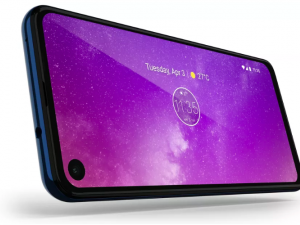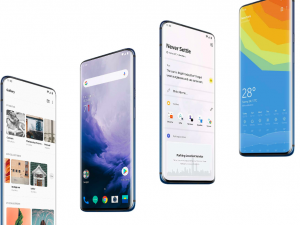The Smartphone Industry Is Fresh Out Of Ideas
Damien McFerran 27/02/2019 – 2:31pm
This year's Mobile World Congress proves it
In case you hadn't noticed, the smartphone industry is in decline. Last year, millions of people decided to stick with their current phone and as a result, Q4 2018 was the fifth straight quarter of declining smartphone shipments. The year-long decline was marked at 4 percent, which might not seem like much, but is the start of a trend which needs to be arrested as quickly as possible. The thing is, smartphone makers don't have the slightest clue about how to do it.
There hasn't been a genuine advancement in the smartphone sector for a while now. Sure, bezel-less screens are nice, but it's a trend that has already run out of steam. Handset makers are resorting to all kinds of tricks to tempt buyers, including device-to-device wireless charging, multiple rear-facing cameras and pop-up selfie cams – none of which really seem to have much of an effect, outside of making one phone slightly different to all the others.
This year's Mobile World Congress – the show where the smartphone sector shows off all of its big ideas for the next 12 months – was hoped to be a turning point; a glorious demonstration that would restore faith in the sector and make sure all those stubborn consumers would be reaching for their wallets over the next few months.
Instead, MWC 2019 has given us more gimmicks and little in the way of true innovation. We've got tall phones, second screens, phones masquerading as batteries and even handsets which scan your hand to unlock. There's a lot of variety on display, which at least proves that these companies are trying to do something different – but none of these ideas will convince stay-at-home consumers to upgrade.

The market seems to be focused on folding phones and the way in which they will give the industry the much-needed shot in the arm it so badly requires, but nothing I've seen so far gives me any confidence that these handsets will be anything more than a technological folly; 2019's glasses-free 3D phones, if you will.
I've previously stated that I think folding phones are a dead end; these are devices created purely to show off how clever smartphone makers have become, with little consideration given for how they will improve the mobile experience, beyond giving us bigger displays to use. With Samsung opting for a screen that closes on itself and Huawei taking the opposite approach and allowing the display to 'wrap' around the outside, it's clear that there's no set idea about how best to use this tech. The fact that these companies were curiously reluctant to allow the press to handle their folding phones also causes alarm bells to ring; what is there to hide here?
Are these folding phones going to withstand bumps and drops, and what material is being used to cover the screen? It can't be glass as glass doesn't bend, so we're probably looking at plastic – and anyone who has used a cheap smartphone will know that plastic touchscreen suck. They're nowhere near as nice to use as glass ones, and this could well be why Samsung and Huawei don't want press handling the phones too early, lest they kill the growing hype for these super-expensive products.
Speaking of price, for what's being asked – around £2,000, by all accounts – it would be utterly foolish to think of folding phones as the saviour of the smartphone market in 2019. Even if folding phones do catch on (and I'm proven wrong), they're not going to be mass market products this year. Instead, it falls to devices like the Galaxy S10 and the upcoming iPhone to keep the market in a fit state, and while it pains me to say it, I can't get excited about either.

The Galaxy S10 is faster, has a bigger screen and more cameras than before, but does it really offer anything new and different? The ultrasonic fingerprint scanner has been seen elsewhere, as has the fancy device-to-device charging. There's nothing new here; it's just last year's template with a 'hole punch' screen. If you held off buying the Galaxy S9, I'm not sure why you'd rush out to spend almost a grand on the S10 – unless your current phone is on its last legs.
That's not to say the S10 won't be amazing – in fact, when we review it, I fully expect us to give it a glowing recommendation. But the yearly upgrade cycle is doing more harm to the smartphone industry than good; is it really a device that we have to update every single year? Is there an argument for smartphone makers only updating their flagship phones every 24 months? It might seem foolish to even think about this, but it would at least mean that we can extract ourselves from this needless 12-month update pattern.
5G is perhaps the only glimmer of hope on the horizon, and once the networks are up to speed it would be prudent to expect a massive upswing in smartphone purchases – especially as 5G is being billed as an even bigger step forward than 4G was. But again, this isn't a 'feature' as such, but an improvement in overall data speeds – and every phone will have 5G in a few year's time, so it's not like it's a design innovation that will reinvigorate the industry.
Perhaps the smartphone as we know it has reached its most perfect, final form; a slab of (mostly) screen in the palm of your hand which takes amazing photos, surfs the web, plays movies, music and games and is small enough to slip effortlessly into your pocket. Does it need to be anything else? If the answer to that question is no, then expect the smartphone sector to remain largely static while companies like Sony, LG, Samsung and Xiaomi all try and create unique devices cursed by needless gimmicks in the name of 'progress'.
Or perhaps I just got out of the wrong side of bed this morning and everything will be fine.




